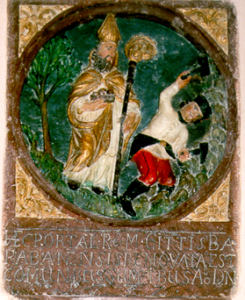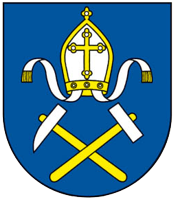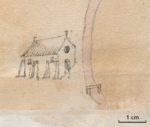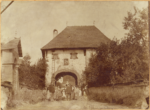Bakabánya

Bakabánya (Slovakian: Pukanec, German: Bugganz / Puk(k)an(t)z, Turkish: Bukabak) is located on the Felvidék aka Upper Hungary/Horná Zem, it is in Slovakia. It was in Hont County, it used to be one of the rich cities of the Mining Town district of the Hungarian Kingdom. More exactly, it was on the most southern part of the Mining Town district so it was often the target of the Ottoman raids in the 16th-17th centuries.

The Slovakian name of Bakabánya, Pukanec comes from the German Bugganz which was the exclusive name of the grand noble family of the Hont-Pázmány clan, the first known owner of Baka. You can learn more about this wealthy region on my page:
https://www.hungarianottomanwars.com/essays/the-mining-towns-of-upper-hungary/
The place was founded by the Benedictine monks of the Monastery of Garamszentbenedek (now Hronsky Benadik) in 1075 and it was a mining town where silver and other precious ore were mined. Its name derives from the old Hungarian “Baka” family name. The document of the “Black monks” describes the borders of ownership of land given by the Hungarian King to the Monastery: outside these borders, there was a land of miners. It was mentioned as “Terra Banensium” (mining territory) in 1156.

The Saint Miklós church was built in the 13th century, originally with two towers; they were pulled down and the new tower was built in the 19th century, 1864. The church was protected by a wall in the 14th century. The Szent Miklós church is famous for the four richly carved and decorated winged altars from the craftsmen of Lőcse (Levoča, Leutschau) and for the Gothic statues. (They are from 1470-1490, see them at the end of my article.) The church was enlarged in 1510.

The first written mention of silver ore is made in 1270 and the first Hungarian name for the town was recorded in 1290 as “Bakabanya“. The place was called “Németbaka” in 1310, “német” means “German” in the Hungarian language. The first man who received mining privileges in 1317 from King Károly Róbert was called Comes György. He had the right to mine gold, silver, and other ores. King Károly Róbert granted town rights to Bakabánya in 1323. Just 22 years later, it became a free royal mining town.

You can see the magnificent pictures better here:
http://www.meryratio.hu/bakabanyai-szent-miklos-templom
The significance of the town was increasing and King Zsigmond declared a free mining enterprise and ordered to build fortifications in 1405. The first mention of the town’s fort is from 1437. From 1424 until 1548, along with other mining towns it was the property of the Hungarian queens.

The Ottoman attacks
The smaller Turk raids were increasing in the second part of the 16th century. In April 1564, the Turks, attacking from the south, appeared below the city gates but were repulsed. The Hungarian Diets repeatedly voted for funds between 1569 and 1655 for the building of fortifications in Bakabánya. Money was issued in 1570, and 1578 just like in 1647 and 1650, and Italian-style bastions were built to support its walls. Some of the southeastern parts of these walls are still visible.

However, the Turks successfully raided and sacked the town on 1 October 1640, causing great suffering. They repeated it in 1652 so the Hungarian Diet sent 50 cavalrymen to reinforce the town in 1659. It was not enough because the enemy could take it in 1664. Moreover, they stayed there for 22 years. It became a Sanjak of Uyvar eyalet and its Turkish name was Bukabak. These events marked the beginning of Bakabány’s decline when much of its population was killed and the mines were slowly depleted.

The year 1686 brought tremendous relief to the town as the Ottomans were driven out of the kingdom. The slaughtered German miners were replaced by Slovakian settlers who were successfully building up the ruined place and Emperor Leopold gave the ancient privileges back to the town. He even allowed the town in 1702 to hold four country-wide fairs annually. The rebel “kuruc” troops of Prince Rákóczi Ferenc took the town in 1703-1704.

Towards the end of the 18th century (in 1774), only one mine was still rich in gold. The last record of mining in Bakabánya was in 1842, though some mining activity continued until 1891. In 1876, the settlement was demoted from the royal free mining town to a municipality belonging to Hont County. Now, the population is mainly Slovakian, only 6 Hungarians lived there in 2011.

If you like my writings, please feel free to support me with a coffee here:
You can check out my books on Amazon or Draft2Digital, they are available in hardcover, paperback, or ebook:
https://www.amazon.com/dp/198020490X or at https://books2read.com/b/boYd81
My books “33 Castles, Battles, Legends” and “The Ring of Kékkő Castle”:

My work can also be followed and supported on Patreon: Become a Patron!http://Become a Patron!
Here are some more pictures of Bakabánya, including the masterpieces made by the Masters of Lőcse in the 1470s:
















































